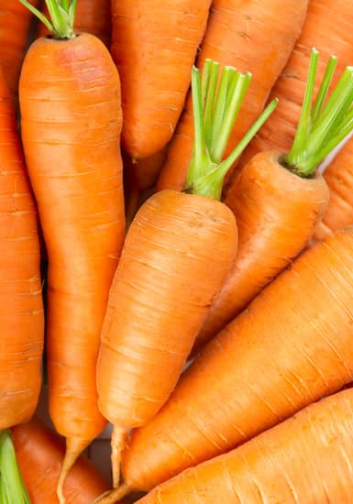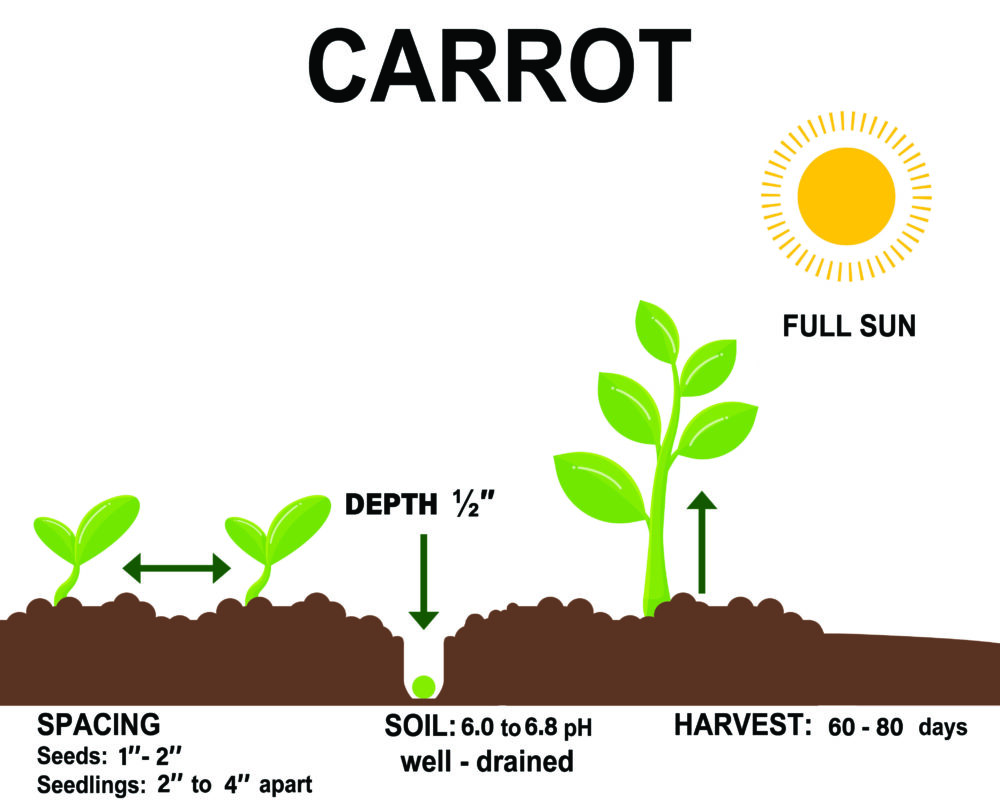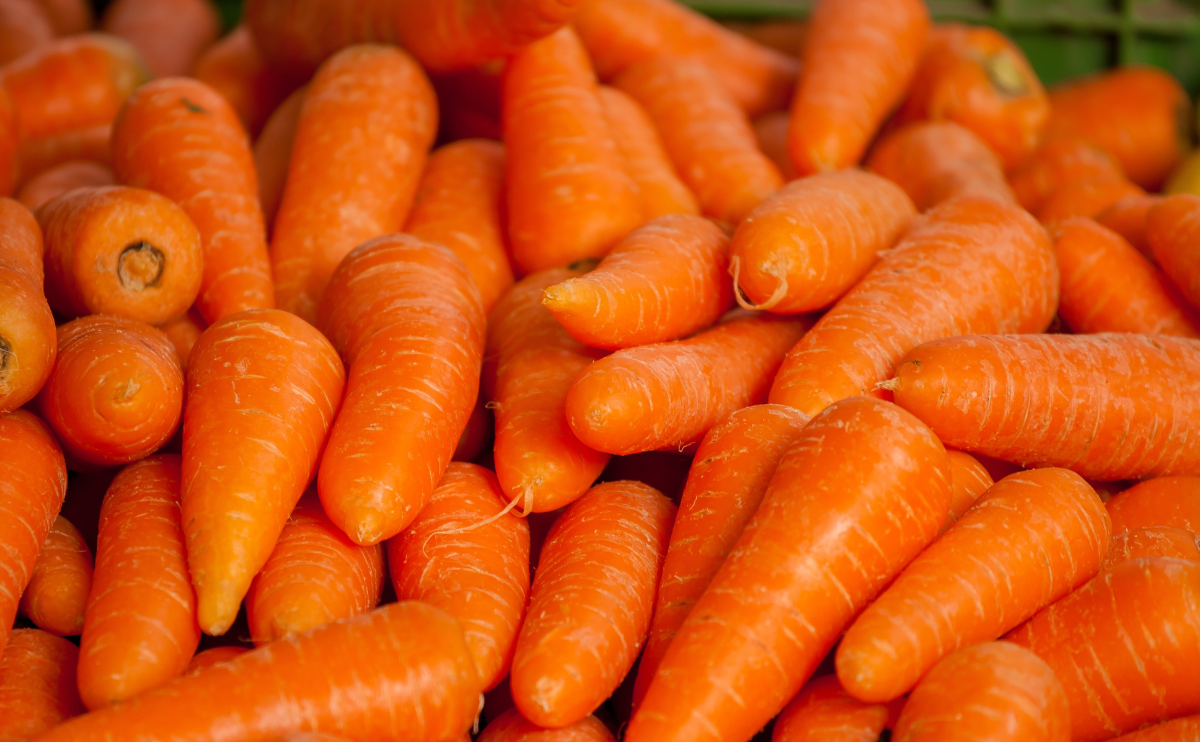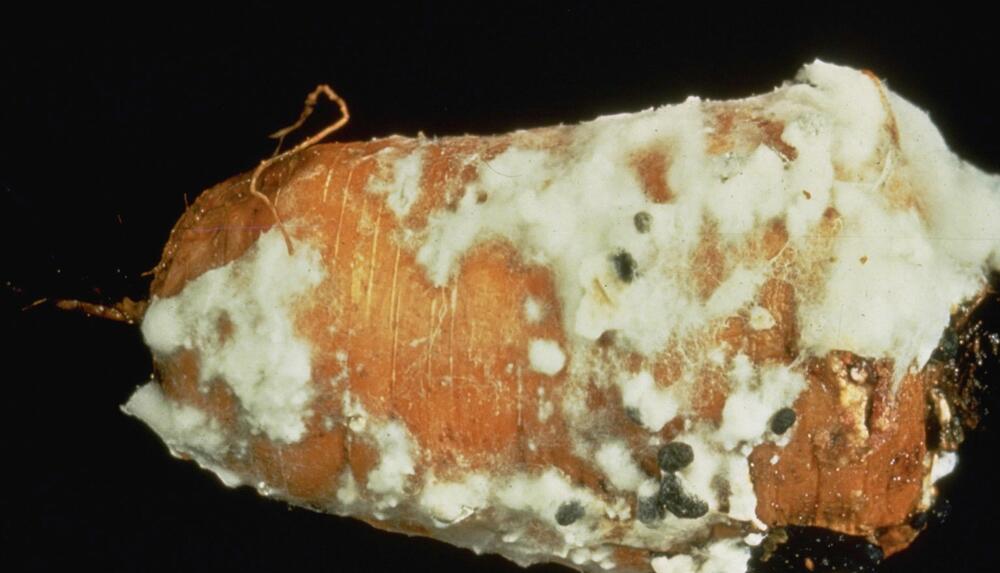Carrots are biennial vegetables, though they are typically harvested in their first year of growth before they overwinter and set flowers the following year. Carrot foliage is finely dissected with fern-like compound leaves. Carrot flowers have five petals and sepals and are born in compound umbels. Most carrot roots are about one inch in diameter and anywhere from one inch to more than 12 inches long. Carrots are best known for long, orange roots, but they actually come in several colors and shapes.
Plant carrots in the spring and seeds will germinate in 10 to 21 days. From seed to harvest typically takes 50 to 75 days.

| Common Name | Carrot |
| Botanical Name | Daucus carota |
| Family | Apiaceae or Umbelliferae |
| Plant Type | Vegetable |
| Size | 6 to 12 inch root, 1 foot foliage height; 9 inch spread |
| Sun Exposure | Full sun to part shade |
| Soil Type | Loose, well-draining soil |
| Soil pH | Slightly acidic (6.0–6.8) |
| Bloom Time | Spring (second growing season) |
| Hardiness Zones | 3–10 (biennial grown as an annual) |
| Native Area | Europe, Southwestern Asia |

When to Plant?
This will be determined by your planting zone. There is a final frost date for each area. As a result, you can plan your gardening activities around this date. Check our Frost Dates Across North America: First & Last Frost Dates Chart. However, the date will not be the same for every plant.
How to Plant
Plant carrots 2 – 3 weeks before the last frost, 1/2 “deep, 1″ – 2″ apart, in rows 12″ to 24” apart. Carrot seeds do not germinate quickly. They germinate unevenly within a 1 to 3 weeks period. Keep the soil moist but do not overflow to speed up germination. Try to thin out the plants so they don’t interfere with each other. Remove the smallest and scrawniest carrots before the plants are 4 inches tall.

A good harvest of high-quality carrot roots requires soil that is loose, deep, high in organic matter, and free of stones, as the roots can split and twist in rocky soil. The preferred pH is 6.0 to 6.5.
To help the soil retain moisture and stay cool, mulch it. Carrots can continue to be planted every three weeks in mid-summer for continuous feeding. For the fall harvest, seeds should be sown 10 – 12 weeks before the first frost. The optimum temperature for carrots is between 60°F and 70°F.
How to Cultivate
Water – Like most vegetables, growing carrots need a minimum of 1 inch of water every week. In case there is no adequate supply from rainfall, water the soil. Make sure to soak the soil completely when you water your carrots. If you only wet the soil’s surface, the roots will not grow as deeply. If your soil is particularly sandy, you may need to water your crops more often.
Soil – 6.0 to 6.8 pH, well-drained
Spacing – seeds – 1″ – 2″
Seedling – 2″ – 4″
Seed life: 3 years
Sun: Full sun
Germination: 7 – 21 days, 55°F – 75°F
Day to Harvest: 60 – 80 days
How to Harvest
You can pick the carrots when they turn bright orange, which usually takes 60 to 80 days. Carrots can be harvested for a long time because they remain fresh in the soil for several months, even after the tops have been killed by frost.
Hydroponics
Germination: Start by soaking your carrot seeds in water for about 24 hours. Once they have soaked, spread them out on a damp paper towel and place it in a warm, dark area. After a few days, the seeds should start to sprout. Once they have sprouted, you can transfer them to your hydroponic setup.
pH Range: The pH range for growing carrots hydroponically should be between 6.0 and 6.5. It’s important to monitor the pH level regularly using a pH meter and adjust it if necessary.
EC: The electrical conductivity (EC) level for growing carrots hydroponically should be between 1.5 and 2.5 mS/cm. This measures the level of nutrients in the water, so it’s important to monitor it regularly using an EC meter.
PPM: The parts per million (PPM) level for growing carrots hydroponically should be between 800 and 1400 ppm. This also measures the level of nutrients in the water, so it’s important to monitor it regularly using a PPM meter.
Humidity: The humidity level for growing carrots hydroponically should be around 60-80%. You can measure the humidity level using a hygrometer and adjust it as necessary by increasing or decreasing the amount of airflow in your grow room.
Light Hours: Carrots require at least 12-16 hours of light per day. You can use LED grow lights or natural sunlight to provide the required amount of light.
Temperature Air: The temperature in the grow room should be around 60-70°F during the day and 50-60°F at night. It’s important to keep the temperature consistent to avoid stress on the plants.
Temperature water: The temperature of the water should be between 60-75°F. You can use a water heater or chiller to maintain the correct temperature.
With these guidelines, you should be able to grow healthy plants hydroponically. Good luck, and happy growing!



